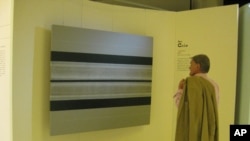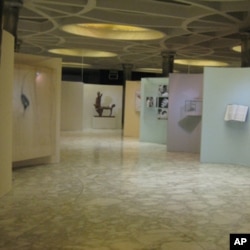The Vatican - once the world’s premier art patron - is again reaching out to artists, organizing an exhibit of contemporary works. Sixty living artists, including two Americans, were invited to reflect on the theme of truth and charity.
U.S. artist Max Cole, 75, was one of them. She found herself shaking hands with Pope Benedict while standing in front of the painting she submitted to the Vatican's exhibit.
“I thank you very much for embracing the spirit of art and the artist,” she said to the pontiff.
Most of the artists in the exhibit are European. The second American in the show is photographer Jackie Nickerson. The artists were asked to reflect on a particular theme: the splendor of the truth and the beauty of charity.
"We asked these 60 artists to reflect on this theme," says Richard Rouse, who helped organized the show for the Pontifical Council for Culture, the Vatican body behind the exhibit. "Some of them asked for a bit of a dialogue and a conversation, so we sent them some of the texts that the Holy Father has written on this theme."
In addition to painting, sculpture, and jewelry, the exhibit features photographs, poems and music.
The exhibit is part of the Vatican’s bid to reconcile with contemporary art.
The Vatican was once the world’s most important art patron. In the 16th century, Pope Julius the Second commissioned Michelangelo to paint the ceiling of the Sistine Chapel. Raphael was hired to paint the pope's portrait.
But in recent centuries, art and the Roman Catholic Church have gone their separate ways. The secular world - governments, foundations, collectors and museums - have taken over as patrons. Additionally, contemporary artists have often used religious symbols to provoke rather than inspire.
The Vatican show has received mixed reviews.
"If really the Vatican wants to deal and wants to have a dialogue with the international audience of contemporary art," says Ludovico Pratesi, an art critic for La Repubblica, a daily newspaper in Rome, "maybe we have to do something more carefully on the real range of international artists in the world."
Independent art curator Sergio Risaliti is more forgiving. At least, he says, the Church is trying to engage with artists. "It is not entirely experimental, but you have to understand that it is the Church. It's not a museum of contemporary art."
In any case, artist Max Cole is grateful. “I think that Pope Benedict is extraordinary in his welcome and it’s much appreciated.”
Her entry, in acrylic on linen, called ‘Saltflat’, is made up of horizontal lines cross-hatched with intricate strokes. The stripes seem to vibrate, giving the impression of a dry salty lake bed, shimmering under a blazing sun.
Cole says her paintings are inspired by the harmony in nature. “In a sense they become ritualistic. They're a bit like prayer or a rosary or eastern meditation."
Cole's paintings are in collections around the world. And now, she's at the Vatican.
Her painting, along with the work of the 59 other living artists, is on view at the Paul VI Assembly Hall at the Holy See, until September 4.














